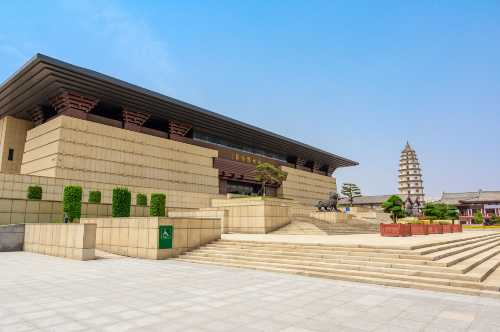Popular Trip Moments
Six cozy small cities reachable within 1 hour by high-speed rail from Beijing to avoid the crowds, set off this weekend | An Yu Chinese Style: A Heartfelt Return to Ancient Charm and Modern Comfort | Dingzhou Weekend Getaway: Discovering the Hidden Gems of Hebei | Han Qi: An Honest Official and Sage-like Figure | A dazzling array of exquisite jewelry from the Ming and Qing dynasties at Dingzhou Museum | Dingzhou Museum | Go Ashore, Come to the Gongyuan | Meet Dingzhou, fall in love with Dingzhou, and never want to leave | Tomb of King of Zhongshan | Explore Dingzhou Kaiyuan Temple Pagoda: Ancient Charm and Modern Style | Dingzhou Zhongshan Han Tombs | Back from Dingzhou, I don't recommend going in December | 【Hebei Province】Dingzhou City Museum. . | Millennium Temple | Dingzhou Mosque. | Check in at Dingzhou Kaiyuan Temple Pagoda. | Dingzhou Gongyuan | Confucius Temple & Gongyuan (Imperial Examination Hall). | 8 Ancient Towns to Visit in Hebei! | Check in at Hebei Dingzhou Museum. | Dingzhou, Hebei - Return to the thousand-year-old ancient city. | Zhongshan Han Tomb, Dingzhou. | Dingzhou Gongyuan | Get nervous as soon as you enter the examination room. | Dingzhou Summer | It's different from what's on TV. | Hebei Dingzhou Confucius Temple | The teacher is the most sacred and unique. | Hebei Dingzhou | Kaiyuan Pagoda, with a history of 900 years. | These two newly opened gardens in Dingzhou are free and perfect for taking beautiful photos. | Dingzhou, the "granary of central Hebei", was once the capital of Zhongshan Kingdom! | The throat of the Nine Provinces, no wonder the Northern Song Dynasty's glass grapes were unearthed here! | The beauty that has thrived through ten centuries | These two Northern Song Dynasty underground palaces are truly amazing
Recommended Attractions at Popular Destinations
Attraction near Bangkok | Attraction near Manila | Attraction near Tokyo | Attraction near Taipei | Attraction near Hong Kong | Attraction near Seoul | Attraction near Kuala Lumpur | Attraction near Los Angeles | Attraction near Shanghai | Attraction near New York | Attraction near Shenzhen | Attraction near Osaka | Attraction near Singapore | Attraction near London | Attraction near Guangzhou | Attraction near San Francisco | Attraction near Beijing | Attraction near Macau | Attraction near Bali | Attraction near Jakarta | Attraction near Paris | Attraction near Ho Chi Minh City | Attraction near Istanbul | Attraction near Phuket | Attraction near Chicago | Attraction near Seattle | Attraction near Toronto | Attraction near Orlando | Attraction near Cebu | Attraction near Chiang Mai
Popular Attractions
Corinth Canal | Jinshanling Great Wall | Dali Ancient City | Toei Kyoto Studio Park | Ubud | Caohu Region of Rivers and Lakes | The Sanctuary of Truth | Mount Fuji | Sumtseling Monestery | Furong Cave | Meridian Gate | Thang Long Water Puppet Theatre | Wan Gu Building | Hong Kong Macau Ferry Terminal | Zoo Negara Malaysia | Kentiba W/Tsadik Public Park | Kuber BALI ADVENTURE | Sid Luckman Field | Game Over Auckland | Redwoods Treewalk | Cenotaph at Tsurugidake | Masjid "At Taubah" | De Drom | Vers l'Amour | Wongabirrie Park | Redeemer Lutheran Church | Jebel Ali Carton Factory Inc. | Gminny Ośrodek Kultury i Turystyki | Kali Temple ( কামারপাড়ার কালী মন্দির
Popular Restaurants in Dingzhou
汉堡王(定州大世界店) | BI SHENG KE DING ZHOU DA SHI JIE DIAN | 直隶安家罩饼(崇文街店) | XING FU DIAO HONG BEI | Xilaidengdangaoliansuo (jinjie) | Xilaidengdangaoliansuo (beimenjie) | Xilaidengdangaoliansuo (jianshejie) | Xilaideng (fuyuan) | Xilaidengdangaoliansuo (bolingjie) | Xilaidengdangaoliansuo (huayuanxiaoqu) | 喜来登生日蛋糕(清城店) | Xilaidengdangaoliansuo (erzhong) | 金权道韩式自助烤肉火锅(大世界店) | 海底捞火锅(定州万达店) | 东北老字号烧烤海鲜(博陵街店) | 肯德基(开元店) | 中山宴(定州署店) | 京娘户鳗鱼烤肉(定州万达店) | 中山国际酒店-餐饮部 | 老张凉皮(中山中路店) | 尼小仙(大世界店) | 老北京烤鸭 | 大王烤鸭(大世界广场店) | 双马肉食部(建设小区店) | 乐堡士·汉堡炸鸡(定州福源店) | Yuweijingzhichongqinglao Hot Pot (dashijieguangchang) | Yangguofu Spicy Hot Pot (shangyejie) | Handouguomutan Barbecue (mingyuejie) | 咘嘎咕市井火锅(宋街店) | 比格比萨自助(定州万达店)
Popular Ranked Lists
Popular Best Things to Do in Xinchang | Popular Premium Hotels in Tehran | Popular Luxury Hotels in Ramatuelle | Popular Luxury Hotels Near Alexandroupolis | Popular Must-Visit Restaurants in Macau | Popular Premium Hotels Near Saint-Herblain | Popular Best Things to Do in Lichuan | Popular Luxury Hotels Near Prienai District Municipality | Popular Premium Hotels in Oakland | Popular Must-Visit Restaurants in Athens | Popular Best Things to Do in Zhijiang | Popular Luxury Hotels Near Madinet Al Bayadeyah | Popular Luxury Hotels Near Fishers | Popular Best Things to Do in Sheyang | Popular Must-Visit Restaurants in Frankfurt | Popular Luxury Hotels Near Sin el Fil | Popular Luxury Hotels Near Anatolikos Olimpos | Popular Premium Hotels Near Samosdelka | Popular Luxury Hotels Near Bungokho | Popular Premium Hotels in Tehran Province | Popular Luxury Hotels Near Banbury | Popular Must-Visit Restaurants in Melbourne | Popular Must-Visit Restaurants in Chaozhou | Popular Must-Visit Restaurants in Hong Kong | Top 6 Best Things to Do in Kathmandu | Popular Must-Visit Restaurants in Hanoi | Top 9 Local Restaurants in Lushan Global Geopark | Top 4 Best Things to Do in Nanping | Popular Premium Hotels in Altay City | Popular Best Things to Do in Cangzhou
Payment Methods
Our Partners
Copyright © 2025 Trip.com Travel Singapore Pte. Ltd. All rights reserved
Site Operator: Trip.com Travel Singapore Pte. Ltd.
Site Operator: Trip.com Travel Singapore Pte. Ltd.








































